JohnQuixote
Ideal_Rock
- Joined
- Sep 9, 2004
- Messages
- 5,212
I’d like to thank everyone for coming to the 1/31/07 “webcast,” especially Bill Lieberum for giving technical insight. Here is a promised follow-up 'for the record.'
Two FAQs about Brilliancescope and ACA
#1. How do ACA diamonds perform on BrillianceScope?
Examples are below. Several years ago we had it for a trial period. 50 diamonds were measured and we enjoyed analyzing the results. At the conclusion of the trial we made the decision that we prefer human eyes to sliding scales when helping clients with final decisions of taste among closely-matched diamonds.
The purpose of this graphic is a general impression, simply to correct the occasional misperception that ACAs ‘fall-short’ because we don’t have the machine in-use.

Notes: A few of these stones may be near-ACA which eventually wound up in Expert Selection, but all were produced on the same factory floor. Since the time of this trial we have tightened the ACA range and GemEx has updated their software.
Two FAQs about Brilliancescope and ACA
#1. How do ACA diamonds perform on BrillianceScope?
Examples are below. Several years ago we had it for a trial period. 50 diamonds were measured and we enjoyed analyzing the results. At the conclusion of the trial we made the decision that we prefer human eyes to sliding scales when helping clients with final decisions of taste among closely-matched diamonds.
The purpose of this graphic is a general impression, simply to correct the occasional misperception that ACAs ‘fall-short’ because we don’t have the machine in-use.

Notes: A few of these stones may be near-ACA which eventually wound up in Expert Selection, but all were produced on the same factory floor. Since the time of this trial we have tightened the ACA range and GemEx has updated their software.









300x240.png)